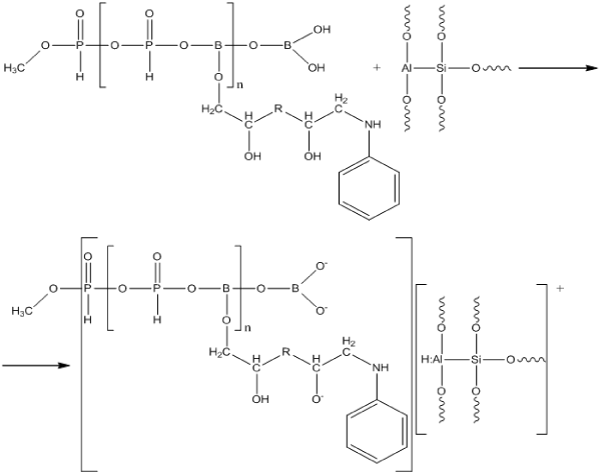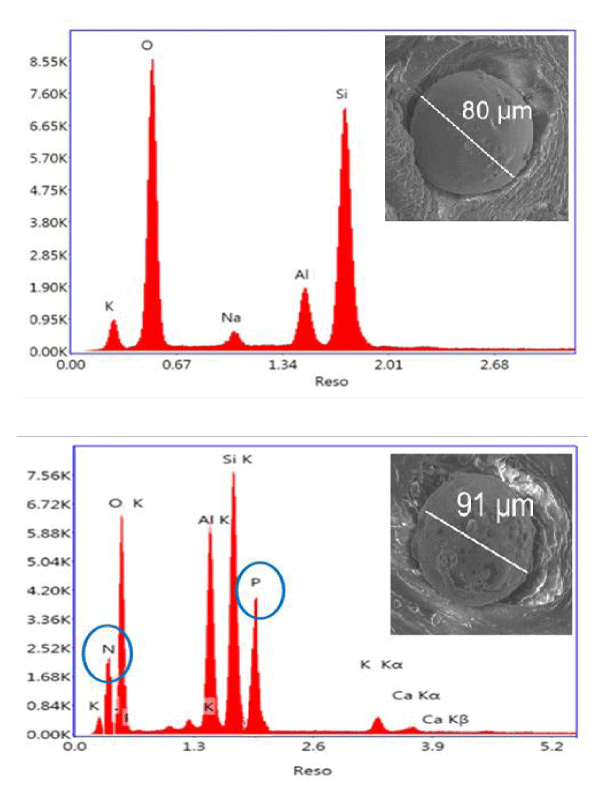Open Journal of Chemistry
Elastomer Thermal Protection Materials Containing Aluminosilicate Microspheres
VF Kablov*, VG Kochetkov, OM Novopoltseva and NA Keibal
Cite this as
Kablov VF, Kochetkov VG, Novopoltseva OM, Keibal NA (2020) Elastomer Thermal Protection Materials Containing Aluminosilicate Microspheres. Open Journal of Chemistry 6(1): 011-012. DOI: 10.17352/ojc.000017Elastomer Fire- Heatprotective Materials (FHPM) are used in the construction, working in extreme temperatures (in the missile, aviation and space technology). Various flame retardant systems are using to create a flame and heat resistant elastomeric compositions, the main drawback of which is the toxicity. Mineral fillers can be used to solve this problem, for example perlite, silicon carbide.
The hollow Aluminosilicate Microspheres (AHM) are part of the fire-retardant coatings [1], high-strength lightweight concrete, and heat insulating ceramic. It was investigated influence of AHM treated with phosphorus boron nitrogen containing oligomer to fire-heat resistant elastomeric compositions.
Previous studies have shown that the introduction the AHM into elastomeric composition allows to increase fire-heat resistance of vulcanizates, however, in the process of mixing a certain part of AHM is broken. There was carried out pretreatment of AHM by phosphorus-boron-nitrogen-containing oligomer (PEDA) to preserve the integrity of the microspheres (Figure 1). This makes it possible to form at AHM surface protective film, and improve the heat-shielding characteristics of the entire composition because PEDA is flame retardant [2].
The surface-chemical interaction of FEDA and microspheres is confirmed by IR Fourier spectral analysis. When exposed to temperature (temperature ~ 165 °C, a hydroxo-group – aluminum coordination bond may occur, as evidenced by some shift of the peaks to the low-wave region. The occurrence of the surface-chemical interaction between FEDA and microspheres is also confirmed by the presence of peaks in the region of 900-1050 and 1100-1200 cm-1 characteristic for P-O-R and P = O bonds, respectively, which indicates the conservation of FEDA molecules on the MSF surface after extraction. The presence of vibrations in the region of 1000–1110 cm–1 may indicate the occurrence of the Si – O – R bond. The occurring modification may also be indicated by the appearance of peaks of atomic nitrogen and phosphorus on the surface of microspheres (Figure 2). Data obtained using a Versa 3D scanning electron microscope.
The purpose of the research is the investigation of the possibility to use the hollow aluminosilicate microspheres, pretreatment by phosphorus-boron-nitrogen-containing oligomer – a basic material of a grinding sludge as a functionally active filler in the fire resistant elastomeric materials.
The object of the study is ethylenepropylenediene rubber vulcanizates EPDM 40 with sulfuric vulcanizing group. Mixtures were prepared in laboratory rollers 160х320 mm. Vulcanization was carried out at a temperature of 165 °C.
Implementation of the modification process is proved by elemental analysis (scanning electron microscope Versa 3D) surface treated AHM.
On the surface treated microspheres appear peaks corresponding to the presence of nitrogen and phosphorus atoms. The absence of boron peaks due to the fact that its atoms are not fixed device.
The treated AHM introduced in elastomer compositions based on EPDM rubber with a sulfuric vulcanization group, and containing 1 pbw. AHM and PEDA from 1 to 3 pbw.
Rheometric characteristics determined in accordance with GOST 12535-84 on rheometer MDR 3000 Professional. The introduction into the elastomer composition treated microspheres PEDA has no significant effect on the kinetics of vulcanization.
Physical and mechanical properties of the vulcanizates were determined by tensile testing machine MRI-60 according to GOST 270-75 “Rubber. The method of determining the elastic properties of tensile strength.”
The strength of vulcanizates containing microspheres treated by PEDA higher than the control sample by 16-25%. There are observed increase of adhesion strength with increasing content of FEDA. It may be associated with the occurrence of additional bonds between the macromolecules of the rubber and the surface of the microspheres, modified elementorganic oligomer.
Fire-heat resistance of samples was determined by the warm-up time the unexposed side of the sample to 100 °C under the action of plasmatron flames.
Introduction to the elastomeric composition from 1 to 3 pbw of PEDA heating time increases almost 2 times. Sample weight loss is reduced by 18-36%. When introduced into polymer microspheres longitudinal layered structure is formed as films separated by thinnest air gaps. As a result, elastic, multilayer heat reflecting labyrinth coating is formed.
Diameter microspheres in the range 20-100 microns, commensurate with the wavelength of the thermal infrared radiation, which provides the conditions for its maximal absorption of microspheres.
There are carried out DTA and TG analyzes that confirm the efficacy of introducing of the microspheres (derivatograph Q-1500 D-V1326, the atmosphere - air). It has been shown that the introduction of investigated additives are increase the temperature of maximum the weight loss at 4%. A further positive factor is the increase in the endothermic peak area at 43.2%, that indicating at occurring during heating energy-intensive processes that enhance the efficiency of heat-shielding material.
Thus, investigations have shown that the use of hollow aluminosilicate microspheres, modified by phosphorus- boron- nitrogen-containing oligomer can improve the fire-heat resistant of elastomeric compositions. At the same time by creating on the surface of the microspheres of the protective film of modifier is achieved the preservation of integrity most of the microspheres and there is also a direct delivery of phosphorus-boron-nitrogenous oligomer in the thermal effect zone, that provides more uniform formation of coke structure with a small pore size. Concurrently, there are is an increase in the area of the endothermic peak on the DTA curve due to the introduction organoelement modifier that allows to conclude that improving the efficiency of heat-shielding material.
Funding
This research was funded by a grant of the President of the Russian Federation for state support of young Russian scientists - candidates of sciences no. MK-1802.2020.3.
- Kablov VF, Novopol’tseva ОМ, Kochetkov VG, Pudovkin VV (2017) Physicomechanical, thermal, and flame-retardant properties of elastomer compounds based on ethylene–propylene–diene rubber and filled with hollow aluminosilicate microspheres. Russ J Appl Chem 2: 257-261. Link: https://bit.ly/2ZxYpIl
- Kablov VF, Novopol’tseva ОМ (2016) The main ways and mechanisms to improve fire- and heat resistance of materials. News of Volgograd State Technical University 4: 46-60.
Article Alerts
Subscribe to our articles alerts and stay tuned.
 This work is licensed under a Creative Commons Attribution 4.0 International License.
This work is licensed under a Creative Commons Attribution 4.0 International License.



 Save to Mendeley
Save to Mendeley
